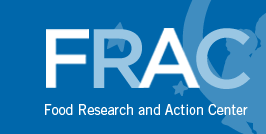Welcome to the Resources Roundup! In this series, the Partners for Breakfast in the Classroom take a look at some of the most powerful resources available to help school nutrition professionals make the case for breakfast-in-the-classroom in their school or district. Experts agree that a data-driven approach is the most effective; whether you’re trying to convince a reluctant principal, or a room full of skeptical classroom teachers, it pays to do your homework—and show your work!
 Today is the second part in this continuing series at BeyondBreakfast.org. Don’t miss our first installment in the series: The Wellness Impact.
Today is the second part in this continuing series at BeyondBreakfast.org. Don’t miss our first installment in the series: The Wellness Impact.
In the second installment of our ongoing Resources Roundup series, we’re going to review the school breakfast information and resources available through the Food Research and Action Center (FRAC). The FRAC website is a veritable treasure trove of school breakfast and breakfast-in-the-classroom facts—let’s take a look.
School Breakfast Scorecard
FRAC’s School Breakfast Scorecard is released annually, and contains data on the School Breakfast Program (SBP) in all fifty states; the 2013-14 report is the most current, and showed an increase of 343,000 additional students eating school breakfast. During SY 2013-14, the SBP served 11.2 million low-income children (daily average).
Not only with the School Breakfast Scorecard give you the ability to provide principals and administrators with hard numbers on the SBP. You can compare state findings, get the picture at the national level, and measure the participation at breakfast compared to school lunch; FRAC’s scorecard also contains strategies—proven to work—to help school breakfast expansion find success. Don’t miss the section on the Community Eligibility Provision, which is helping schools across the country deliver free breakfast—and free lunch—to every student, regardless of family income.
School Breakfast: Making it Work in Large School Districts
FRAC’s ‘Making it Work in Large School Districts’ takes a look at the country’s largest school districts—from 17,000 students in Reading, PA to 1.1 million students in New York City—and puts the spotlight on those that are “going the extra mile” to connect students with their morning meal. If you’re working in a large school district, you’ll find the information in this report to be especially valuable.
Within the report, you’ll take a closer look at cities like Syracuse, Houston, and Kansas City to see how their numbers compare nationally, and by state; get an inside look at Dallas Independent School District where—after implementing a pilot program through Partners for Breakfast in the Classroom—breakfast-in-the-classroom is now served at no charge to every student in the district; learn how the Community Eligibility Provision (CEP) is helping school districts just like yours make universal free breakfast and lunch possible.
School Breakfast State/Local Data Report Toolkit
This tool was created to analyze data for a state or local level report on school breakfast participation and will automatically:
- Calculate the number of low-income children receiving school breakfast for every 100 receiving school lunch in each school or district;
- Rank the schools or districts based on the school breakfast ratio, and
- Calculate the dollars being lost by schools or districts due to low participation
You’ll need to collect some data on schools and school meal participation in your state, as well as days of service, and the report you generate will be a tool in your arsenal to advocate for expanding school breakfast. Don’t miss the handy sidebar of State Sample Reports.
Expanding School Breakfast Participation
 In FRAC’s Expanding School Breakfast Participation section you’ll find a variety of resources: webinars, videos, fact sheets, an FAQ, as well as links to external school breakfast resources like the Partners for Breakfast in the Classroom.
In FRAC’s Expanding School Breakfast Participation section you’ll find a variety of resources: webinars, videos, fact sheets, an FAQ, as well as links to external school breakfast resources like the Partners for Breakfast in the Classroom.
School Breakfast Outreach
The School Breakfast Outreach section is designed to help you organize your efforts to implement or expand school breakfast. Here you will find ideas to help you spread the word about school breakfast throughout the school year, as well as an ‘action plan’ for various stakeholders—legislators, school staff, and administrators.
The Outreach Resources sidebar includes a great many links to additional resources to help you earn support—and possibly funding—for school breakfast; Fuel Up to Play 60, National Dairy Council, and Action for Healthy Kids, to name a few.
Stay tuned for the next blog in this series—Partners for Breakfast in the Classroom Resources Roundup: NEA Health Information Network’s Breakfast in the Classroom Toolkit.

Pingback: Partners for Breakfast in the Classroom Resources Roundup: NEA Healthy Futures Breakfast in the Classroom Toolkit
Pingback: Partners for Breakfast in the Classroom Resources Roundup: NEA Healthy Futures Breakfast in the Classroom Toolkit
Pingback: In the News: ANC in Salt Lake City, Community Eligibility, and Culinary Boot Camp for School Nutrition Professionals
Pingback: In the News: ANC in Salt Lake City, Community Eligibility, and Culinary Boot Camp for School Nutrition Professionals